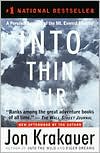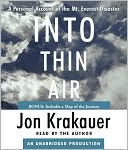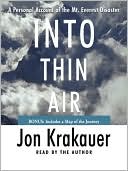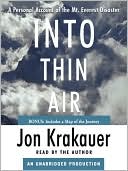Into Thin Air: A Personal Account of the Mount Everest Disaster
National Bestseller \ A bank of clouds was assembling on the not-so-distant horizon, but journalist-mountaineer Jon Krakauer, standing on the summit of Mt. Everest, saw nothing that "suggested that a murderous storm was bearing down." He was wrong. The storm, which claimed five lives and left countless more—including Krakauer's—in guilt-ridden disarray, would also provide the impetus for Into Thin Air, Krakauer's epic account of the May 1996 disaster.\ By writing Into Thin Air, Krakauer...
Search in google:
A childhood dream of someday ascending Mount Everest, a lifelong love of climbing, and an expense account all propelled writer Jon Krakauer to the top of the Himalayas last May. His powerful, cautionary tale of an adventure gone horribly wrong is a must-read. Galen Rowell Ranks among the great adventure books of all time. -- The Wall Street Journal
In March 1996, Outside Magazine sent me to Nepal to participate in, and write about, a guided ascent of Mount Everest. I went as one of eight clients on an expedition led by a well-known guide from New Zealand named Rob Hall. On May 10 I arrived on top of the mountain, but the summit came at a terrible cost.\ Among my five teammates who reached the top, four, including Hall, perished in a rogue storm that blew in without warning while we were still high on the peak. By the time I'd descended to Base Camp nine climbers from four expeditions were dead, and three more lives would be lost before the month was out.\ The expedition left me badly shaken, and the article was difficult to write. Nevertheless, five weeks after I returned from Nepal I delivered a manuscript to Outside, and it was published in the September issue of the magazine. Upon its completion I attempted to put Everest out of my mind and get on with my life, but that turned out to be impossible. Through a fog of messy emotions, I continued trying to make sense of what had happened up there, and I obsessively mulled the circumstances of my companions' deaths.\ The Outside piece was as accurate as I could make it under the circumstances, but my deadline had been unforgiving, the sequence of events had been frustratingly complex, and the memories of the survivors had been badly distorted by exhaustion, oxygen depletion, and shock. At one point during my research I asked three other people to recount an incident all four of us had witnessed high on the mountain, and one of us could agree on such crucial facts as the time, what had been said, or even who had been present. Within days after the Outside article went to press, I discovered that a few of the details I'd reported were in error. Most were minor inaccuracies of the sort that inevitably creep into works of deadline journalism, but one of my blunders was in no sense minor, and it had a devastating impact on the friends and family of one of the victims.\ Only slightly less disconcerting than the article's factual errors was the material that necessarily had to be omitted for lack of space. Mark Bryant, the editor of Outside, and Larry Burke, the publisher, had given me an extraordinary amount of room to tell the story: they ran the piece at 17,000 words — four or five times as long as a typical magazine feature. Even so, I felt that it was much too abbreviated to do justice to the tragedy. The Everest climb had rocked my life to its core, and it became desperately important for me to record the events in complete detail, unconstrained by a limited number of column inches. This book is the fruit of that compulsion.\ The staggering unreliability of the human mind at high altitude made the research problematic. To avoid relying excessively on my own perceptions, I interviewed most of the protagonists at great length and on multiple occasions. When possible I also corroborated details with radio logs maintained by people at Base Camp, where clear thought wasn't in such short supply. Readers familiar with the Outside article may notice discrepancies between certain details (primarily matters of time) reported in the magazine and those reported in the book; the revisions reflect new information that has come to light since publication of the magazine piece.\ Several authors and editors I respect counseled me not to write the book as quickly as I did; they urged me to wait two or three years and put some distance between me and the expedition in order to gain some crucial perspective. Their advice was sound, but in the end I ignored it — mostly because what happened on the mountain was gnawing my guts out. I thought that writing the book might purge Everest from my life.\ It hasn't, of course. Moreover, I agree that readers are often poorly served when an author writes as an act of catharsis, as I have done here. But I hoped something would be gained by spilling my soul in the calamity's immediate aftermath, in the roil and torment of the moment. I wanted my account to have a raw, ruthless sort of honesty that seemed in danger of leaching away with the passage of time and the dissipation of anguish.\ Some of the same people who warned me against writing hastily had also cautioned me against going to Everest in the first place. There were many, many fine reasons not to go, but attempting to climb Everest is an intrinsically irrational act — a triumph of desire over sensibility. Any person who would seriously consider it is almost by definition beyond the sway of reasoned argument.\ The plain truth is that I knew better but went to Everest anyway. And in doing so I was a party to the death of good people, which is something that is apt to remain on my conscience for a very long time.
\ From Barnes & NobleA powerful, cautionary tale of adventure gone horribly wrong, Into Thin Air became an instant bestseller upon publication. A childhood dream of some day ascending Mt. Everest, a lifelong love of climbing, and an expense account all propelled writer Jon Krakauer to the top of the Himalayas in May 1996. With a guide claiming "We've got the mountain wired," Krakauer found that for 65 grand, you could climb the world's tallest peak. This hubris, and a freak storm, claimed the lives of seven members of his expedition, and narrowly avoided killing Krakauer and many more.\ \ \ \ \ Galen RowellRanks among the great adventure books of all time. -- The Wall Street Journal\ \ \ Entertainment WeeklyWrenching. . .lucid. ..it is impossible to read this book unmoved.\ \ \ \ \ Michiko KakutaniA compelling chronicle of bad luck, bad judgment, and doomed heroism. \ —New York Times\ \ \ \ \ Publishers WeeklyWhat set out to be a magazine article on top-of-the-line tours that promise safe ascents of Mt. Everest to amateur climbers has become a gripping story of a 1996 expedition gone awry and of the ensuing disaster that killed two top guides, a sherpa and several clients. "Climbing Everest was primarily about enduring pain," writes Krakauer (Into the Wild). "And in subjecting ourselves to week after week of toil, tedium and suffering... most of us were probably seeking, above all else, something like a state of grace." High-altitude climbers are an eccentric breedOlympian idealists, dreamers, consummate sportsmen, egomaniacs and thrill-seekers. Excerpts from the writings of several of the best-known of them, including Sir Edmund Hillary, kick off Krakauer's intense reports on each leg of the ill-fated expedition. His own descriptions of the splendid landscape are exhilarating. Survival on Mt. Everest in the "Dead Zone" above 25,000 feet demands incredible self-reliance, responsible guides, supplemental oxygen and ideal weather conditions. The margin of error is nil and marketplace priorities can lead to disaster; and so Krakauer criticizes the commercialization of mountaineering. But while his reports of guides' bad judgments are disturbing, they evoke in him and in the reader more compassion than wrath, for, in the Dead Zone, experts lose their wits nearly as easily as novices. The intensity of the tragedy is haunting, and Krakauer's graphic writing drives it home: one survivor's face "was hideously swollen; splotches of deep, ink-black frostbite covered his nose and cheeks." On the sacred mountain Sagarmatha, the Nepalese name for Everest, the frozen corpses of fallen climbers spot the windswept routes; they will never be buried, but in this superb adventure tale they have found a fitting monument.\ \ \ \ \ Library JournalOn May 19, 1953, Edmund Hillary and Sherpa guide Tenzing Norgay achieved the impossible, becoming the first men to stand on top of Mount Everest. But by May 10, 1996, climbing the 29,000-foot 'goddess of the sky' had become almost routine; commercial expeditions now littered Everest's flanks. Accepting an assignment from Outside magazine to investigate whether it was safe for wealthy amateur climbers to tackle the mountain, Krakauer joined an expedition guided by New Zealander Rob Hall. But Krakauer got more than he bargained for, when on Summit Day a blinding snowstorm caught four groups on the mountain's peaks. While Krakauer made it back to camp, eight others died, including Scott Fischer and Hall, two of the world's best mountaineers. Devastated by the disaster, Krakauer has written this compelling and harrowing account (expanded from his Outside article) as a cathartic act, hoping it 'might purge Everest from [his] life.' But after finishing this raw, emotionally intense book, readers will be haunted, as Krakauer was, by the tragedy.\ —Wilda Williams\ \ \ \ \ Library JournalOn May 19, 1953, Edmund Hillary and Sherpa guide Tenzing Norgay achieved the impossible, becoming the first men to stand on top of Mount Everest. But by May 10, 1996, climbing the 29,000-foot 'goddess of the sky' had become almost routine; commercial expeditions now littered Everest's flanks. Accepting an assignment from Outside magazine to investigate whether it was safe for wealthy amateur climbers to tackle the mountain, Krakauer joined an expedition guided by New Zealander Rob Hall. But Krakauer got more than he bargained for, when on Summit Day a blinding snowstorm caught four groups on the mountain's peaks. While Krakauer made it back to camp, eight others died, including Scott Fischer and Hall, two of the world's best mountaineers. Devastated by the disaster, Krakauer has written this compelling and harrowing account (expanded from his Outside article) as a cathartic act, hoping it 'might purge Everest from [his] life.' But after finishing this raw, emotionally intense book, readers will be haunted, as Krakauer was, by the tragedy.\ —Wilda Williams\ \ \ \ \ School Library JournalHeroism and sacrifice triumph over foolishness, fatal error, and human frailty in this bone-chilling narrative in which the author recounts his experiences on last year's ill-fated, deadly climb. Thrilling armchair reading.\ \ \ \ \ Entertainment WeeklyWrenching. . .lucid. ..it is impossible to read this book unmoved.\ \ \ \ \ Michiko KakutaniA compelling chronicle of bad luck, bad judgment, and doomed heroism. -- The New York Times\ \ \ \ \ Alastair ScottKrakauer's chronicle, selected as one of the best books of the year by the editors of the Book Review, has "a lucid and terrifying intimacy." -- The New York Times Book Review\ \ \ \ \ Kirkus ReviewsAnd onto thin ice—Krakauer's hypnotic, rattling, first-hand account of a commercial expedition up Mt. Everest that went 'way wrong. In the spring of 1996, Krakauer took an assignment from Outside magazine to report on the burgeoning industry of commercially guided, high-altitude climbing. Many experienced alpinists were dismayed that the fabled 8,000-meter summits were simply 'being sold to rich parvenues' with neither climbing grace nor talent, but possessed of colossal egos. From childhood, Krakauer had wanted to climb Everest; he was an expert on rock and ice, although he had never sojourned at Himalayan altitudes. While it has become popular to consider climbing Everest a lark and the South Col approach little more than a yak route, Krakauer found the altitude a malicious force that turned his blood to sludge and his extremities to wood, that ate his brain cells. Much of the time he lived in a hypoxic stupor, despite the standard acclimatization he underwent.\ As he tells of his own struggles, he plaits his tale with stories of his climbing comrades, describes the often outrageous characters on other expeditions, and details the history of Everest exploration. The writing builds eerily, portentously to the summit day, fingering little glitches that were piling up, 'a slow accrual, compounding imperceptibly, steadily toward critical mass,' when a rogue storm overtook the climbers; typical by Everest standards, it was ferocious in the extreme. Time collapses as, minute-by-minute, Krakauer rivetingly and movingly chronicles what ensued, much of which is near agony to read. Unjustly, Krakauer holds himself culpable for aspects of the disaster, but this book will serve animportant purpose if it gives even one person pause before tackling Everest.\ \ \



